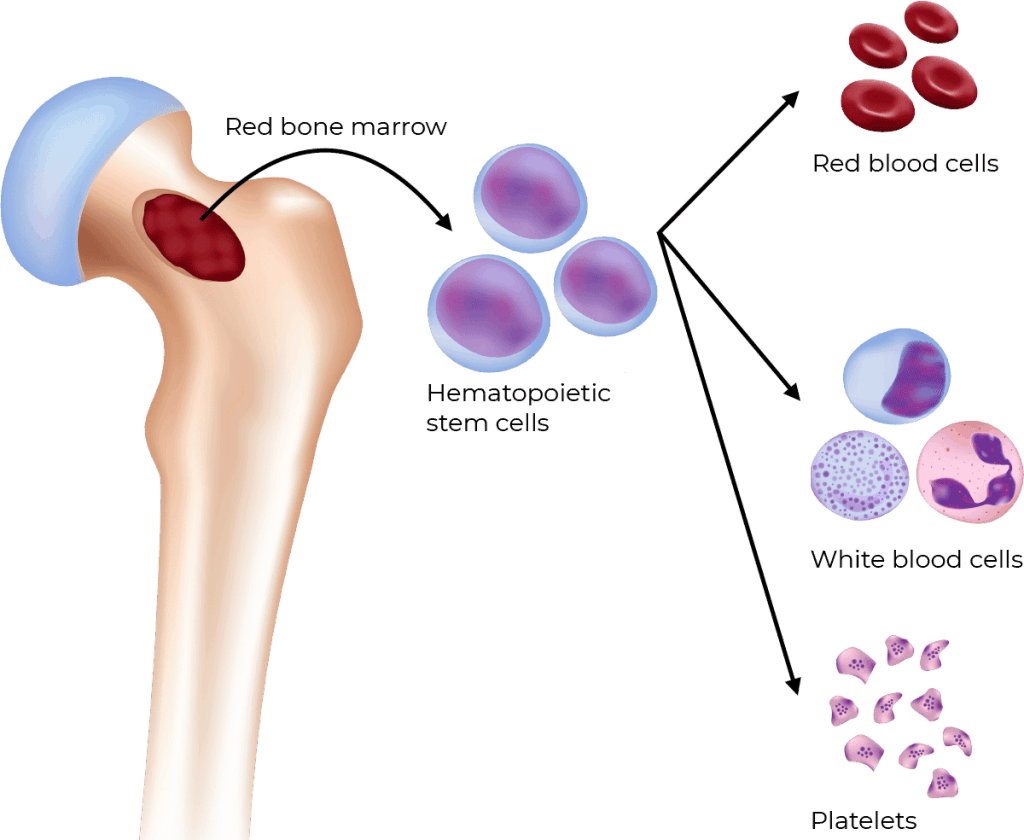In short, HSCT for MS is a treatment for multiple sclerosis, in which the old diseased immune system is momentarily destroyed with a high dose of chemotherapy. This destruction is followed by a reinfusion of the patient’s own blood stem cells, which were harvested before the chemo. This transplantation promotes recovery of the immune system.
In many cases, this procedure appears to be able to cause a sort of ‘reset’ of the immune system, after which acute MS-inflammations no longer seem to occur.
Hematopoietic stem cells

Hematopoietic stem cells, HSCs; also known as blood stem cells, are immature blood cells that reside in the red bone marrow. This is a soft sponge-like material inside of bones. These blood-forming stem cells either multiply to form more stem cells, or they develop into one of three types of blood cells.
Red blood cells (erythrocytes) that transport oxygen, white blood cells (leukocytes) that fight off infections, or platelets (thrombocytes) that facilitate blood clotting.
Stem cells differ from other cells in the body because they can differentiate into different types of cells.
Hematopoietic stem cells can only differentiate into blood cells, not into other cells. This means that these cells cannot repair nerve damage caused by MS.
The HSCT for MS procedure
There are quite some differences between the treatments offered by the various centers that provide HSCT for MS. I will discuss those differences in more detail in the future.
Here I will give a general overview of the HSCT for MS treatment.
Home
An MS patient that comes to the hospital for the treatment usually has a normal amount of white blood cells roaming around in his or her blood, and hardly any hematopoietic stem cells.
Mobilization
Almost all HSCs are located in the red bone marrow. In this first phase, the mobilization phase, the bone marrow is stimulated to produce stem cells and to release them into the bloodstream (peripheral circulation). This is usually done by a short pulse of chemotherapy, often cyclophosphamide, followed by injections of a growth-stimulating factor for a couple of days.
Aphaeresis of stem cells
Now that there is a great number of stem cells in the bloodstream, they can be ‘harvested.’ For this, a tube is placed in a vein through which blood is pumped to a so-called aphaeresis machine. This machine separates stem cells from the blood and collects them. Through a second tube, the rest of the blood is returned to the patient. The aphaeresis takes about 5 hours.
The harvested stem cells are prepared in a lab, frozen and saved until they can be returned to the patient.
Conditioning
After the aphaeresis and a resting period, the so-called ‘conditioning’ phase follows. Before the reinfusion of the harvested stem cells, the patient is treated with a high dose of chemotherapy to destroy immune cells and in some cases also the bone marrow. Different centers use different kinds of chemotherapy agents in this phase.
Transplantation
After conditioning, the previously harvested stem cells are thawed and returned to the patient. The actual time for infusion varies, but it typically ranges from 30 minutes to two hours.
Recovery
The last part of the HSCT procedure is engraftment and recovery. During this time, the infused stem cells find their way back to the bone marrow and repopulate it; this is called engraftment.
After the chemotherapy patients enter a critical phase in which all blood cell counts are far below normal levels. During this period patients are at risk of infections, so precautions must be taken to avoid exposure to microbial pathogens. Infections during this time can cause severe complications.
It is good to realize that a shortage of red blood cells and platelets can be supplemented through blood transfusions. However, a lack of white blood cells cannot be alleviated by a blood transfusion. Donor immune cells would see the patient’s own tissues as foreign and start to attack them.
Therefore antibacterial, antiviral and antifungal drugs are given during this period.
As soon as the patient’s blood counts surpass a certain threshold for a couple of days, the patient can leave the hospital.
If you want to know more about the HSCT procedure. The European Group for Blood and Marrow Transplantation, EBMT, has an excellent booklet online that provides detailed information about the procedure.